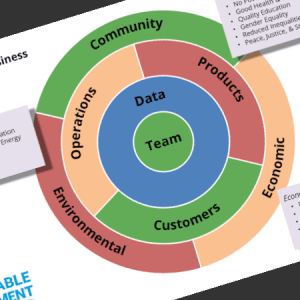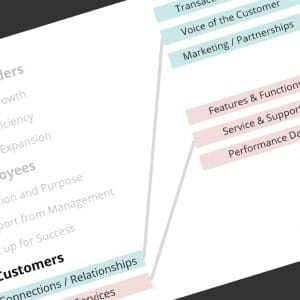Each functional area in your company needs to understand the skills and strengths that they bring to a Digital Transformation effort; why do they deserve a “seat at the table”? Next up is Sales & Marketing - with their depth of experience with design and focus on the end customer, Sales & Marketing can and should play a critical role. (part of a series)
Perhaps the most visible and exciting part of your Digital Transformation is the chance to bring the “cool stuff” from the world of consumer technology into the realm of Business, the “enterprise”, B2B. There are many lessons that old-line B2B companies to take from this hyper-competitive world of B2C – and expectations are growing for B2B companies to present themselves more like the consumer companies that we deal with every day in our personal lives.
Why is it (many people ask) that my electronic life at home is so much better than my electronic life at work? Why do the screens have to look this way, why does it have to be so hard to get information? Why can’t I “google” and “app” my way through the business day?
The Marketing team is often best positioned to truly understand what is happening in the world of consumer electronics and consumer digital capabilities; the darwinian impact of rapid, continuous iteration, highly engaged customers, in a highly competitive market. This style of development and change has driven a focus on concepts of design – for eye appeal, sure, but more importantly for easy to understand process, elegantly designed flow, and an extreme focus on understanding where value is created.
In this environment, what can Marketing bring to the table to drive your transformation into a Great Digital Business?
- Design Thinking for Process: So many legacy internal systems and processes are blessed with legendary difficulty. People love to complain about how tough it is to enter customer data, transact orders, or ship product. And let’s not limit our thinking to technology; how many of us still rail against the amazing bureaucracy that springs up out of nowhere in organizations. This is truly a case where size doesn’t matter – even the smallest companies come up with strangely archaic processes that are insensitive to the user. Your Marketing team has to describe products and services in a way that your customers can easily understand; the Sales folks often get involved helping customers navigate your own Internal Operations so we can get the invoice to them and get their payment quickly. The same ideas and experiences are applicable to internal process – a great opportunity for customer-sensitive folks to apply simplification and clear communications to how things get done, every single day.
- Design Thinking for Information: How about applying design thinking to the complex information that comes out of our digital systems? We have all labored through illegible spreadsheets printed in the tiniest font, because someone insisted that these reports should all fit on an 8.5”x11” sheet of paper. And how many times can we watch another presentation with nothing but bullet points and poorly justified text, showing poorly presented ideas that could easily be summarized into a single picture or a three-point set of priorities? Visualizing the insights that are trapped in data sets can be a difficult task – communicating the complexity of ideas is an area where Marketing absolutely can lead the team.
- Voice of the Customer: Successful marketing teams are already tuned in and listening to the Customer, understanding their requirements, and designing solutions to service those needs. But why is it so hard to apply that same kind of thinking to internal processes? Why can’t we think of our peers in the organization – the other functional areas that have to interact with these processes, understand the customer information, or work with products – why can’t we think of those folks as Customers? And if we see them as Customers, shouldn’t we be listening to their thoughts and ideas on how to improve these processes? When we see our internal peers as Customers, we will know how to better listen to and understand them – and this new way of working will have a big impact. It doesn’t matter that we are not charging the folks in Finance, say, for HR services – you don’t have to be a paying customer to be treated like a person.
- Identifying Value: At the start of the day, Sales & Marketing helps external Customers understand our Products and the value that they bring. This is a process of education and effective communication; we are introducing new capabilities and trying to get our Customers to change their minds and processes, and invest their time & money differently. A difficult task – and powerful stuff when done well. We can apply the same thinking to the change required when going through a Digital Transformation; this is a process of education and effective communication, where we are introducing new ways of thinking and new ways of leveraging Digital “stuff”, to change the way we operate, connect, and provide value. This ability to communicate the idea of value, and understand how to make it personal for the folks who need to make the change, is a critical skill that Sales & Marketing can bring to process – and coach their peers on building these skills.
- Profitable Revenue: At the end of the day, Sales & Marketing needs to make sure our products and services sell generate more revenue than the cost required to make things happen. Every new dollar is not as good as the last; most companies operate on the idea that steady earnings growth and solid, predictable cash flow are large components of the Enterprise Value equation. This is where Sales & Marketing can make a difference – by understanding what it takes to set the price of a product such that a sustainable business can be built around it. In the same way, the organization has to understand what is the maximum amount of value that these new Digital Transformational ideas will bring to the company – and what is the offsetting cost (in time, effort, and angst) required.
Transformation is change – and Sales & Marketing is arguably the team with the most experience in introducing change successfully. You are used to doing it for our external Customers – now you must turn your attention to your internal teammates.
2 January, 2019
- How Finance can Participate in your Digital Transformation
- How Sales & Marketing can Participate in your Digital Transformation
- How Operations can Participate in your Digital Transformation
- How IT can Participate in your Digital Transformation
- Finance Participation in your Great Digital Business – The Slides
- IT Participation in your Great Digital Business – The Slides






Comments (0)